Buddhist Symbols

According to early Buddhist teachings, the Buddha insisted that his students not make images of him, so that he would not become an object of worship, and distract from the essence of the teachings. Later Buddhist cultures, particularly Tibetan Buddhism, moved away from this restriction, using both the creation of art (including images of Buddha) and contemplation of it as part of meditative practice. But because of the early proscription against doing so, many symbols developed to represent the Buddha and aspects of his teachings. Since over time Buddhism spread across cultures, some Buddhist symbols are culturally specific, but many are not. The list below represents a little of both:
Eight-Spoked Wheel (Dharma Wheel)
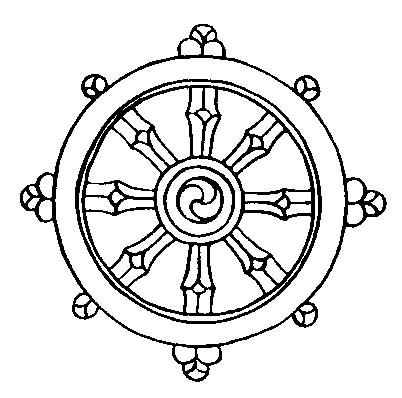 Appearing fairly early in Buddhist history, the spokes of the dharma wheel represent the Noble Eightfold Path, the foundation of the Buddha's teachings on how to cease suffering and awaken.
Appearing fairly early in Buddhist history, the spokes of the dharma wheel represent the Noble Eightfold Path, the foundation of the Buddha's teachings on how to cease suffering and awaken.
Bodhi Tree
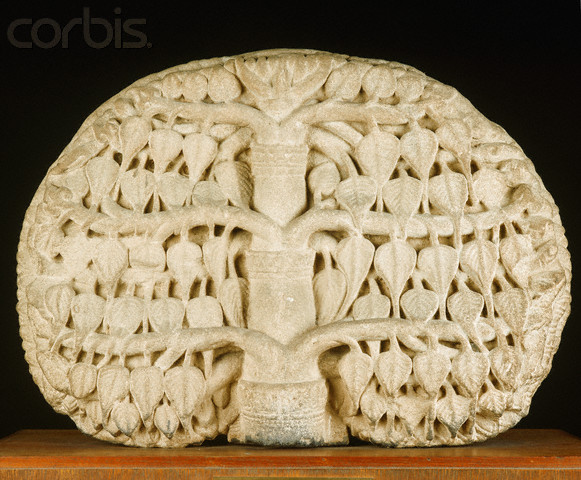 Often depicted in Buddhist art across cultures (such as in this relief from India), the bodhi tree is the tree the Buddha attained enlightenment under, and has come to represent his liberation.
Often depicted in Buddhist art across cultures (such as in this relief from India), the bodhi tree is the tree the Buddha attained enlightenment under, and has come to represent his liberation.
Stupas
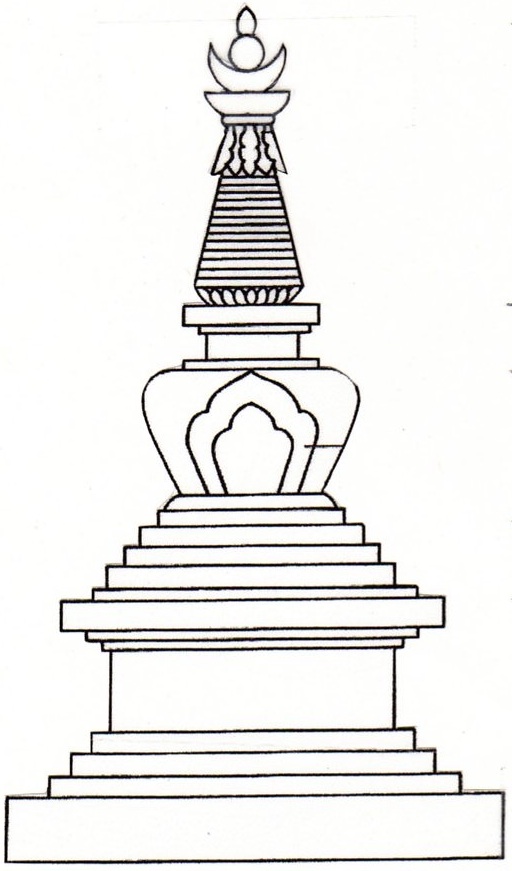 Stupas have been built and depicted in many different Buddhist cultures since the early days of Buddhism. Although there is some variation in shape, this picture depicts a common one. In general, the levels and geometric shapes of a stupa are meant to represent the five elements of earth, water, fire, air and space.
Stupas have been built and depicted in many different Buddhist cultures since the early days of Buddhism. Although there is some variation in shape, this picture depicts a common one. In general, the levels and geometric shapes of a stupa are meant to represent the five elements of earth, water, fire, air and space.
Buddha's Footprints
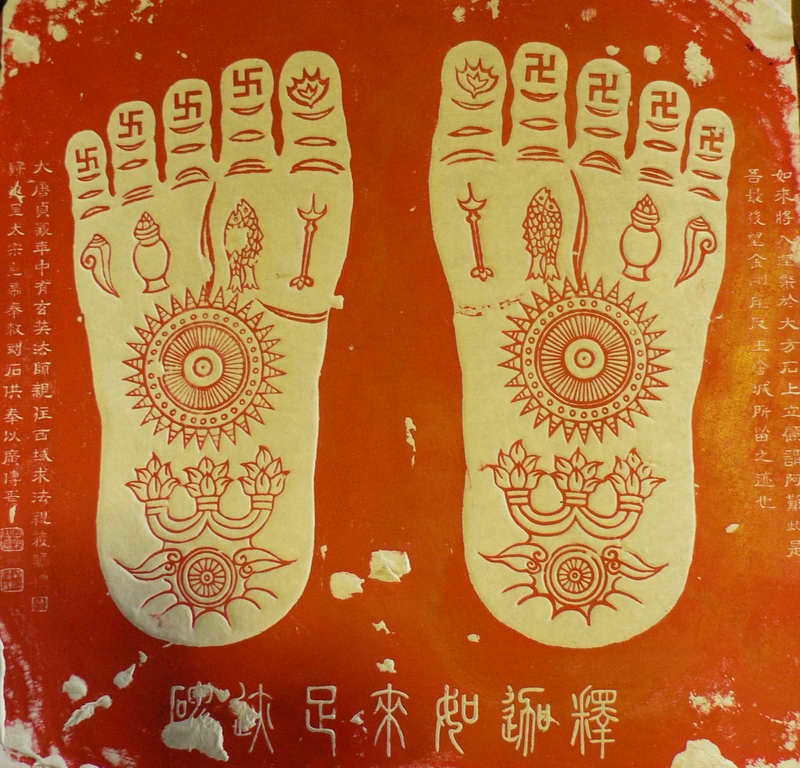 Also found across several Buddhist cultures, the Buddha's footprints represent his physical presence here on earth. Sometimes dharma wheels and other symbols are included on the feet, as in this example.
Also found across several Buddhist cultures, the Buddha's footprints represent his physical presence here on earth. Sometimes dharma wheels and other symbols are included on the feet, as in this example.
Three Jewels
 Represents the Three Jewels of Buddhism - the Buddha (teacher), the Dharma (teachings) and the Sangha (community).
Represents the Three Jewels of Buddhism - the Buddha (teacher), the Dharma (teachings) and the Sangha (community).
Buddha’s Eyes
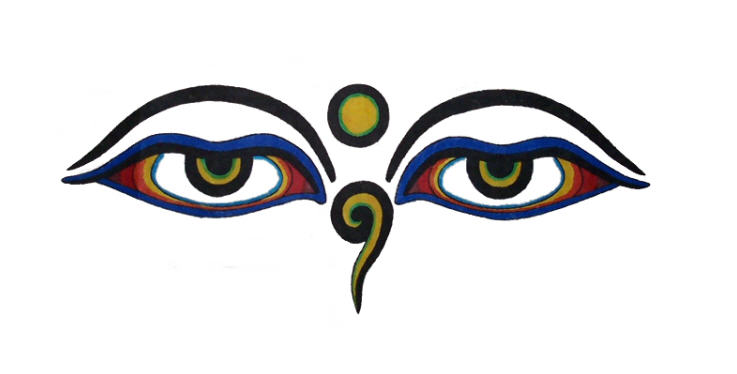 Appearing a bit later in Buddhist history and especially prevalent in Tibet, the Buddha's Eyes represent universal wisdom and omniscience.
Appearing a bit later in Buddhist history and especially prevalent in Tibet, the Buddha's Eyes represent universal wisdom and omniscience.
Swastika
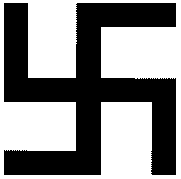 Although of course this symbol developed a negative connotation after the Nazi regime adopted it as its symbol, its history is actually very different. In Hinduism it has long represented the different aspects of the universe and eternity, and several Buddhist cultures adopted it as well. Although interpretations vary, in general when facing left it represents love and mercy, and when facing right is represents strength and intelligence.
Although of course this symbol developed a negative connotation after the Nazi regime adopted it as its symbol, its history is actually very different. In Hinduism it has long represented the different aspects of the universe and eternity, and several Buddhist cultures adopted it as well. Although interpretations vary, in general when facing left it represents love and mercy, and when facing right is represents strength and intelligence.
OM or AUM

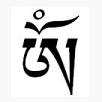 Also drawn from Hinduism, Om is a foundation Buddhist mantra. In India, it is more commonly depicted in Sanskrit (left) and in Tibet, in Tibetan lettering (right.)
Also drawn from Hinduism, Om is a foundation Buddhist mantra. In India, it is more commonly depicted in Sanskrit (left) and in Tibet, in Tibetan lettering (right.)
Lotus
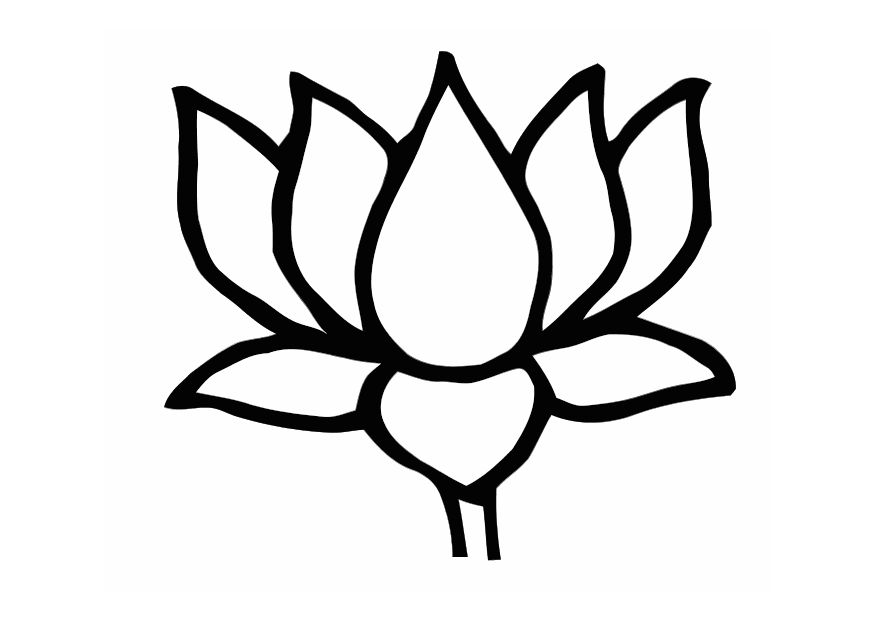 The lotus represents both the process and possibility of enlightenment. The mud it is rooted in represents samsara, the vine reaching up through the water towards the light represents the spiritual process or purification of karma, and the beautiful flower on top represents liberation.
The lotus represents both the process and possibility of enlightenment. The mud it is rooted in represents samsara, the vine reaching up through the water towards the light represents the spiritual process or purification of karma, and the beautiful flower on top represents liberation.
In Tibet, the lotus is one of the Eight Auspicious Symbols, as are the next three:
Wheel of Life
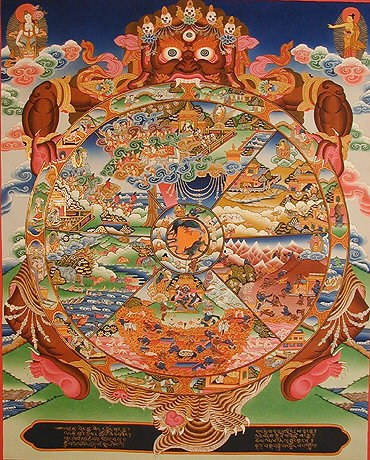 Often depicted in Tibetan mandalas, the Wheel of Life represents the six realms of existence.
Often depicted in Tibetan mandalas, the Wheel of Life represents the six realms of existence.
Conch Shell
 The conch shell, which is used as a horn in Tibet, represents the universal sound of the teachings, appropriate for all beings.
The conch shell, which is used as a horn in Tibet, represents the universal sound of the teachings, appropriate for all beings.
Endless Knot
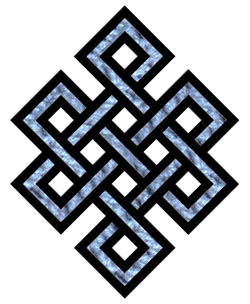 The Endless Knot represents the web of karma and interrelatedness of all beings within existence.
The Endless Knot represents the web of karma and interrelatedness of all beings within existence.
The other 4 of the Tibetan 8 auspicious symbols (not shown here) are the Parasol, the Golden Fishes, the Treasure Vase and Victory Banner.
Zen circle
 One of the few Zen symbols, the Zen circle represents the universe. To draw it in one stroke, as it should be, requires a clear mind and pristine focus.
One of the few Zen symbols, the Zen circle represents the universe. To draw it in one stroke, as it should be, requires a clear mind and pristine focus.
For more info, try:
Eight-Spoked Wheel (Dharma Wheel)
 Appearing fairly early in Buddhist history, the spokes of the dharma wheel represent the Noble Eightfold Path, the foundation of the Buddha's teachings on how to cease suffering and awaken.
Appearing fairly early in Buddhist history, the spokes of the dharma wheel represent the Noble Eightfold Path, the foundation of the Buddha's teachings on how to cease suffering and awaken.Bodhi Tree
 Often depicted in Buddhist art across cultures (such as in this relief from India), the bodhi tree is the tree the Buddha attained enlightenment under, and has come to represent his liberation.
Often depicted in Buddhist art across cultures (such as in this relief from India), the bodhi tree is the tree the Buddha attained enlightenment under, and has come to represent his liberation.Stupas
 Stupas have been built and depicted in many different Buddhist cultures since the early days of Buddhism. Although there is some variation in shape, this picture depicts a common one. In general, the levels and geometric shapes of a stupa are meant to represent the five elements of earth, water, fire, air and space.
Stupas have been built and depicted in many different Buddhist cultures since the early days of Buddhism. Although there is some variation in shape, this picture depicts a common one. In general, the levels and geometric shapes of a stupa are meant to represent the five elements of earth, water, fire, air and space.Buddha's Footprints
 Also found across several Buddhist cultures, the Buddha's footprints represent his physical presence here on earth. Sometimes dharma wheels and other symbols are included on the feet, as in this example.
Also found across several Buddhist cultures, the Buddha's footprints represent his physical presence here on earth. Sometimes dharma wheels and other symbols are included on the feet, as in this example.Three Jewels
 Represents the Three Jewels of Buddhism - the Buddha (teacher), the Dharma (teachings) and the Sangha (community).
Represents the Three Jewels of Buddhism - the Buddha (teacher), the Dharma (teachings) and the Sangha (community).Buddha’s Eyes
 Appearing a bit later in Buddhist history and especially prevalent in Tibet, the Buddha's Eyes represent universal wisdom and omniscience.
Appearing a bit later in Buddhist history and especially prevalent in Tibet, the Buddha's Eyes represent universal wisdom and omniscience.Swastika
 Although of course this symbol developed a negative connotation after the Nazi regime adopted it as its symbol, its history is actually very different. In Hinduism it has long represented the different aspects of the universe and eternity, and several Buddhist cultures adopted it as well. Although interpretations vary, in general when facing left it represents love and mercy, and when facing right is represents strength and intelligence.
Although of course this symbol developed a negative connotation after the Nazi regime adopted it as its symbol, its history is actually very different. In Hinduism it has long represented the different aspects of the universe and eternity, and several Buddhist cultures adopted it as well. Although interpretations vary, in general when facing left it represents love and mercy, and when facing right is represents strength and intelligence.OM or AUM

 Also drawn from Hinduism, Om is a foundation Buddhist mantra. In India, it is more commonly depicted in Sanskrit (left) and in Tibet, in Tibetan lettering (right.)
Also drawn from Hinduism, Om is a foundation Buddhist mantra. In India, it is more commonly depicted in Sanskrit (left) and in Tibet, in Tibetan lettering (right.)Lotus
 The lotus represents both the process and possibility of enlightenment. The mud it is rooted in represents samsara, the vine reaching up through the water towards the light represents the spiritual process or purification of karma, and the beautiful flower on top represents liberation.
The lotus represents both the process and possibility of enlightenment. The mud it is rooted in represents samsara, the vine reaching up through the water towards the light represents the spiritual process or purification of karma, and the beautiful flower on top represents liberation. In Tibet, the lotus is one of the Eight Auspicious Symbols, as are the next three:
Wheel of Life
 Often depicted in Tibetan mandalas, the Wheel of Life represents the six realms of existence.
Often depicted in Tibetan mandalas, the Wheel of Life represents the six realms of existence.Conch Shell
 The conch shell, which is used as a horn in Tibet, represents the universal sound of the teachings, appropriate for all beings.
The conch shell, which is used as a horn in Tibet, represents the universal sound of the teachings, appropriate for all beings.Endless Knot
 The Endless Knot represents the web of karma and interrelatedness of all beings within existence.
The Endless Knot represents the web of karma and interrelatedness of all beings within existence.The other 4 of the Tibetan 8 auspicious symbols (not shown here) are the Parasol, the Golden Fishes, the Treasure Vase and Victory Banner.
Zen circle
 One of the few Zen symbols, the Zen circle represents the universe. To draw it in one stroke, as it should be, requires a clear mind and pristine focus.
One of the few Zen symbols, the Zen circle represents the universe. To draw it in one stroke, as it should be, requires a clear mind and pristine focus.For more info, try:
You Should Also Read:
Buddhist Inspired Coloring Sheets (Printables)

Related Articles
Editor's Picks Articles
Top Ten Articles
Previous Features
Site Map
Follow @mommymystic
Tweet
Content copyright © 2023 by Lisa Erickson. All rights reserved.
This content was written by Lisa Erickson. If you wish to use this content in any manner, you need written permission. Contact Lisa Erickson for details.


